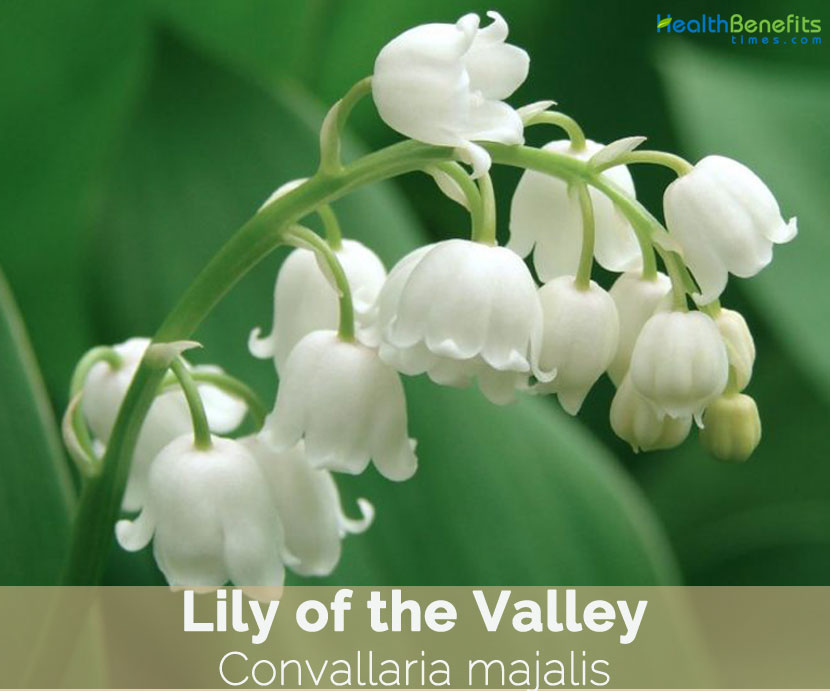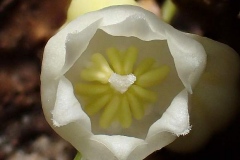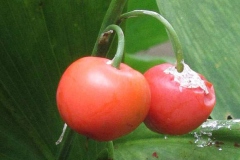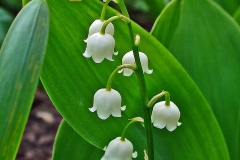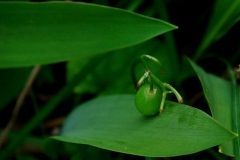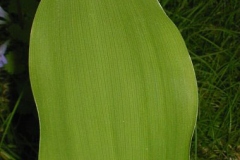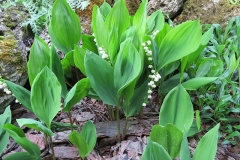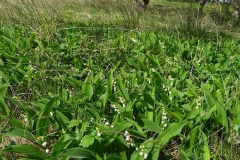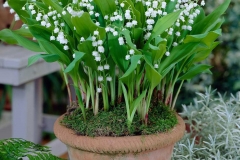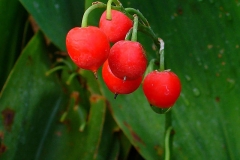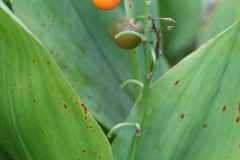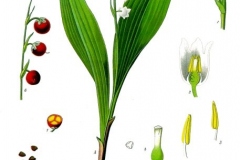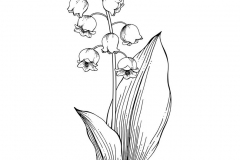May lily, Mary’s tears, Lily-of-the-valley, our lady’s tears, little maybells, fairy cups, muguet, lily constancy, ladder-to-heaven, and Jacob’s ladder are popular common names of the plant. Genus name comes from the Latin word convallis meaning a valley. Specific epithet means of or belonging to May in reference to the month of flowering. Apart from its medicinal and health benefits, wedding bouquets of these sweet smelling, beautiful flowers are carried by brides for good luck and prosperity in married life. Due to its dense content of cardiac glycosides, it is extremely poisonous if consumed by humans or domestic animals. In pre-modern England, the plant was known as glovewort (as it was a wort used to create a salve for sore hands), or Apollinaris (according to a legend that it was discovered by Apollo).
Lily of the Valley Facts
| Lily of the Valley Quick Facts | |
|---|---|
| Name: | Lily of the Valley |
| Scientific Name: | Convallaria majalis |
| Origin | Cool temperate Northern Hemisphere in Asia and Europe |
| Colors | Green when young turning to red as they mature |
| Shapes | Small globoid berries that are 5–7 mm (0.2–0.3 in) diameter |
| Taste | Acrid |
| Health benefits | Good for cardiovascular health, Improves cognitive function, Controls blood pressure, Manages urinary tract infection, Treats depression, Treats chronic lung diseases, Improves kidney health, Treats Irregular Heartbeat, Manages digestion, Manages gout, Mental Problems, Reduces fever, Reduces Scars |
| Name | Lily of the Valley |
|---|---|
| Scientific Name | Convallaria majalis |
| Native | Cool temperate Northern Hemisphere in Asia and Europe |
| Common Names | May lily, Lily-of-the-valley, our lady’s tears, little maybells, fairy cups, muguet, lily constancy, ladder-to-heaven, and Jacob’s ladder |
| Name in Other Languages | Albanian: Konvalare Arabic: Kunafalariana ‘ayar (كونفالاريا أيار) Aragonese: Convalaria, lidio de Puerto, lirio de los valles, pepitos, plantaina de puerto Armenian: Hovtashushan (հովտաշուշան) Azerbaijani: Keysk inciçiçəyi, Yapon inciçiçəyi, İnci çiçəyi Bashkir: Inyı säskä (Ынйы сәскә) Basque: Mugeta Belarusian: Landyš zvyčajny (Ландыш звычайны), Landyš majski (Ландыш майскі), Landış (Ландыш) Breton: Louzaouenn-an-hañv Bulgarian: Momina sŭlza (Момина сълза) Catalan: Conval.lària, convallària, litra, llágrimas de Salomó, llàgrimes de Salomó, lliri convaller, lliri de la Mare de Deu, lliri de maig, muguet, trencalós, lliri convaller Chinese: Ling lan shu (铃兰属) Corsican: Convalaria majalis Croatian: Đurđica Czech: Konvalinka vonná Danish: Liljekonval Dutch: Lelietje-van-dalen, Boslelie, Lelietje van dale, Lelietje-der-dalen, Meiklokje English: European lily of the valley, Lily-of-the-valley, May Lily Esperanto: Konvalo, majfloro Estonian: Harilik maikelluke, Karikelled, Lambakeel, Lillikas, Maikelluke, Piibeleht, Villvallikas Euskera: Larlirijua, mugetatze Finnish: Kielo, Kielot French: Muguet, Muguet de mai, Muguet commun, Convallaria maialis, Gazon du Parnasse, Grillet, Larmes de sainte Marie, Lis de mai, Lis des vallées, Lys de mai, Lys des vallées, clochette des bois, Georgian: Shroshana (შროშანა) German: Maiglöckchen, Maiblume Greek: Minké (Μιγκέ) Hebrew: שושנת העמקים High Aragonese: Lidio de Puerto, lirio de los valles, pepitos, plantaina de puerto Hungarian: Gyöngyvirág Ido: Maifloro Ingush: ChӀagarkӀalg (ЧӀагаркӀалг) Irish: Lile na ngleanntán Italian: Lilium convallium, Mughetti, Mughetto, Giglio delle convalli Japanese: Doitsusuzuran (ドイツスズラン), suzuran (スズラン), Suzuran zoku (スズラン属), kimikage-sôu (キミカゲソウ) Kabardian Circassian: Kielerdegu (Къэлэрдэгу) Kazakh: İnjwgül (Інжугүл), Merwertgül (Меруертгүл) Kurdish: Xeydoka gulanê Lak: Mariyannul mak (Марияннул макь) Latin: Maialis convallaria, Maialis Latvian: Maijpuķīte, Parastā kreimene, kreimene Limburgish: Lelietje der dalen, Meizäödje, Meizäödsje, Muguet Lithuanian: Konovalija, Pakalnutė, Paprastoji pakalnutė Livvi: Neiskelloine Low Saxon: Lilgenkonfal, Lilgenkonfalg, Lilgenkunfal, Lilgenkunfalg, Maibummeln, Maienlill, Maiklocken, Marienklocken, Ogenkruut, Schillerlilg Luxembourgish: Kläckelchersblumm, Meeglëckchen, Meeréischen Macedonian: Momina solza (момина солза) Majorcan: Asucena de valles, muguet Malayalam: Lilli ōph da vāli (ലില്ലി ഓഫ് ദ വാലി Manx: Blaa Boaldyn, Lilee ny glionney, Lilee y choan Northern Sami: Giđđadivgarássi Norwegian: Liljekonvall, Lille conval, Nyseblad Occitan: Muguet Ossetian: Džydžyna (Джыджына), Landış (Ландыш) Persian: زنبق دره Polish: Konwalia leśna, Konwalia majowa, Konvalia Portuguese: Lírio do Vale, campainhas, convallen, lilio dos valles, lirio convale, lirio convalle; lirio dos valles; lírio-convale; lírio-de-maio; lirio-dos-vales; lírio-dos-vales, campaínhas-de-maio, convalária Pashto: سوسن Romanian: Lăcrămioară, lăcrimioară Russian: Landysh mayskiy (Ландыш майский), Landış (Ландыш) Serbian: Đurđevak (Ђурђевак), Đurđica (Ђурђица), Šarenica (Шмарница) Shambala: Đurđevak Slovak: Konvalinka voňavá, konvalinka Slovene: Smarnica Spanish: Convalaria, lirio convalio, lirio de Nuestra Señora, lirio de los valles, lirio salvaje, lágrimas de Salomón, muguet, muguete, mugueto, Šmarnica, lágrimas de Salomón, lirio de los valles, lirio de Puerto, pepitos, plantaina de Puerto Swedish: Kielo, Liljekonvalj, Konvalje, Liljekonvalje, Hjartansfröjd Tajik: Lïvondar (Ливондар) Turkish: Müge, inci çiçeği Udmurt: Тӧдьыгырлы Ukrainian: Konvaliya zvychayna (Конвалія звичайна), Konvaliya travneva (Конвалія травнева) Upper Sorbian: Całtki Valencian: Aszucena borda Vepsian: Jänišankorvaižed Vietnamese: Huệ chuông, Lan chuông, Linh lan Welsh: Lili‘r dyffrynnoedd Western Frisian: Maaieklokje Ksh: Maijlöcksche Ku Arab: خەیدۆکا گولانێ Ku Latn: Xeydoka gulanê Stq: Kuutitte, Moaiklokje, Pingsterbloume |
| Plant Growth Habit | Perennial herbaceous rhizomatous plant |
| Growing Climates | Tamarack bogs, rich deciduous woodlands, pioneer cemetery prairies, oak savannas near pioneer cemetery prairies, and abandoned homestead sites, dry and young forest heaths, ridges, forest margins, rocky ridges, banks, broad-leaved forests and coppices |
| Soil | Easily grown in moist, fertile, organically rich, well-drained soils |
| Plant Size | Up to 12 in (30 cm) tall |
| Root | Fibrous and rhizomatous |
| Stem | Stem bristly, sometimes with purple base |
| Leaf | Paired leaves are long elliptics growing up to 16.7 in (50 cm) long. Leaves are deciduous |
| Flowering season | May to June |
| Flower | Bell like dainty white flowers are held on erect racemes and have a strong, sweet perfume and bloom in the spring |
| Fruit Shape & Size | Small globoid berries that are 5–7 mm (0.2–0.3 in) diameter |
| Fruit Color | Green when young turning to red as they mature |
| Propagation | By seed |
| Taste | Acrid |
| Plant Parts Used | Leaves, flowers, whole herb |
| Seed | 3-4 mm. long and light brown with darker scar tissue at their bases |
| Available Forms | Tea, tincture, extract, infusion and essential oil |
| Season | October |
| Health Benefits |
|
| Culinary Uses |
|
Plant Description
Lily of the Valley is a perennial herbaceous rhizomatous plant that normally grows up to 12 in (30 cm) tall. It often forms widespread colonies by spreading underground stems called rhizomes. New upright shoots are formed at the ends of stolons in summer; these upright dormant stems are often called pips. These grow in the spring into new leafy shoots that still remain connected to the other shoots underground. The plant is found growing in tamarack bogs, rich deciduous woodlands, and pioneer cemetery prairies, oak savannas near pioneer cemetery prairies, abandoned homestead sites, dry and young forest heaths, ridges, forest margins, rocky ridges, banks, broad-leaved forests and coppices. The plant easily grows in moist, fertile, organically rich, well-drained soils. The plant has fibrous and rhizomatous roots. Stem is bristly, sometimes with purple base.
Leaves
Pair of leaves is nearly basal and single racemes of flower occur. The leaf blades are 5-10 inches long, 3-5 inches across, and more or less erect. They are oval-ovate in shape and smooth (entire) along their margins. Both the lower and upper leaf surfaces are medium to dark green, glabrous, and sometimes slightly glaucous. Leaf venation is parallel. The leaves taper into petioles about 1½–3 inches long that wrap around a short basal stalk that is partly underground.
Flower
Between the leaves, there develops a raceme of flowers about 4-9 inches long. This raceme is shorter than the leaves and it tends to nod toward its apex. There are 6-16 flowers per raceme. The central stalk of the raceme is medium green, terete, somewhat slender, and glabrous. The nodding flowers usually occur along one side of the raceme from pedicels that are up to ½ inches long. These pedicels are light green, terete, and glabrous. At the bases of these pedicels, there are solitary floral bracts. These floral bracts are up to 8 mm. long, light green to nearly white, and narrowly lanceolate to ovate in shape. They are shorter than the corresponding pedicels.
The white corollas of these flowers are about 8 mm. (1/3 inches) long and similarly across. They are campanulata (bell-shaped) with 6 short lobes that curve outward. Within the corolla of each flower, there are 6 stamens with short filaments and a single style with a tripartite stigma. The ovary of each flower has 3 cells. The blooming period occurs from late May to early June, lasting about 3 weeks. The flowers are quite fragrant.
Fruits
Fertile flowers are followed by small globoid berries (one berry per fertile flower) that are 5–7 mm (0.2–0.3 in) diameter. The interior of each berry is juicy, containing 1-6 seeds. These seeds are 3-4 mm. long and light brown with darker scar tissue at their bases; they are more or less ovoid in shape, but also rather irregular and chunky. Not all plants produce fruit.
Health benefits of Lily of the Valley
Listed below are some of the well-known health benefits of using Lily of the Valley
1. Good for cardiovascular health
Lily of the valley is considered as a cardiac tonic. It helps in relieving numerous problems concerning to the health of your heart. It is considered to be healthier as well as safer than digitalis or foxglove, other herbs used in treating heart diseases. It is used for treating congestive heart failure, valvular heart disease, dropsy and cardiac debility. Flavonoids present in the herb helps to improve your heart health by encouraging your arteries, thus aiding in dilation of the blood. Compared to other herbs, lily of the valley has been declared as being more effective and safe for senior individuals. The herb is also used in treating arrhythmia as it improves the muscular functioning of the heart. Similarly, it normalizes and controls the rate of your heartbeat by curing irregular heartbeat. Glycosides present in the herb reduce the risk of heart attack.(1), (2)
2. Improves cognitive function
It has been stated that lily of the valley can improve the functioning of the nervous system. The anti-ageing properties of the herb help in limiting the onset of age-related decline in your cognitive skills. Consuming the herb helps in improving the recollection ability, this is a common age-related issue senior individual face. It has been pointed out to have a positive impact on improving memory as well. Lily of the valley is also used in treating epilepsy, and ageing of brain cells.(3)
3. Controls blood pressure
Diuretic properties of the herb aids in dilating your blood vessels. Flavonoids in the plant help in stimulating the arteries, thus easing the flow of blood. This in turn aids in controlling and managing your blood pressure levels.(4)
4. Manages urinary tract infection
Lily of the Valley has diuretic properties that help in improving and increasing the formation of urine in your body. Through this property, the herb helps in flushing out the toxins and infection-causing bacteria from the urinary tract. It also helps by removing the excess amount of water in your body. As the microbes are flushed out from your system, the herb is extremely helpful for curing UTIs. Similarly, the diuretic property of the herb aids in detoxifying your liver, thus getting rid of the harmful toxins. (5)
5. Treats depression
The therapeutic properties possessed by lily of the valley make it helpful in the treatment of anxiety and depression. Essential oil produced from the flower aids in relaxing and calming your mind. It can be applied on the back of your neck or on the temples to cure restlessness as well.
6. Treats chronic lung diseases
Lily of the valley is used in the treatment of Chronic Obstructive Pulmonary Diseases (COPD) such as asthma and emphysema. The herbs ability to ease out your breathing aids in this function. It is also beneficial in the treatment of pulmonary edema.
7. Improves kidney health
Lily of the Valley helps in improving your kidney health by avoiding the deposition of toxins. It also helps by reducing water retention and bloating in your body. Lily of the valley is also beneficial in breaking down the kidney stones.
8. Treats Irregular Heartbeat
Lily of the valley ingested in tea or tincture form can rectify an irregular heartbeat. The poison in this flower reduces the heart beat enabling it to function more rhythmically and regularly. It decreases the myocardium discomfort and stabilizes the heart functions without the aid of any extra oxygen. But carefully measured amounts should be administered under expert supervision, as large amounts could be fatal to health.
9. Manages digestion
The laxative as well as the purgative properties of the herb aids in improving your digestion. It regulates the digestion process, keeping it healthy and avoiding the development of any digestion-related issues. It aids in the smooth excretion of waste and also provides relief from constipation
10. Manages gout
Essential oil extracted from the herb is extremely beneficial in treating gout. You can apply the oil onto the affected areas, such as the joints and bones to reduce the inflammation and the pain.
11. Mental Problems
Legends say that if a person puts the oil of lily of valley on his forehead, it would impart common sense into him! The essential oil of lily of valley is used in aromatherapy to treat headaches, depression, and melancholy. It may also be used to treat memory loss, apoplexy and epilepsy. It is used to strengthen the brain cells and improve the cognitive processes of the brain.
12. Reduces fever
The antipyretic property of lily of the valley is beneficial in treating fevers. It helps by controlling the blood circulation in your body, which in turn helps in reducing your body temperature.
13. Reduces Scars
An ointment made of lily of valley is used for treating burns and other wounds without leaving any scars. It is also helpful in healing the scar tissues quickly and effectively.
Traditional uses and benefits of Lily of the Valley
- Lily of the valley has a long and proven reputation in herbal medicine in the treatment of heart complaints.
- It contains the glycosides convallarin and convallamarin which are powerful cardiac tonics and diuretics and are also used in allopathic medicine.
- All parts of the plant are antispasmodic, cardio tonic, strongly diuretic, emetic, febrifuge, laxative and sedative.
- The plant is usually harvested when in flower and can be dried for later use, though it is stronger acting when fresh.
- Inflorescence is said to be the most active medicinally and is often harvested separately.
- An infusion of the flowers and roots is a digitalis substitute (obtained from Digitalis species), though less powerful, that is especially useful in the treatment of valvula heart diseases, cardiac debility, dropsy and chronic lung problems such as emphysema.
- Lily of the valley encourages the heart to beat more slowly, regularly and efficiently, at the same time it is strongly diuretic, reducing blood volume and lowering blood pressure.
- Its effect is less cumulative than digitalis which makes it safer for elderly patients.
- It is often recommended combined with the fruits of Crataegus spp.
- An ointment made from the roots is used in the treatment of burns and to prevent scar tissue.
- Essential oil of lily of the valley is used to relieve depression, imbue gentleness, happiness, modesty, a sweet disposition and sense of security.
- The herb has been used for weak contractions during childbirth as well as for epileptic seizures, strokes, angina and ensuing paralysis, conjunctivitis, and leprosy.
- Lily of the valley has been recommended for strengthening the brain and rejuvenating a weak memory.
- It was often used in the past as antidote for gas poisoning (especially during the WWI), in treatment of heart disorders, epilepsy, skin burns and to induce sedation.
Lily Of The Valley Scented Oil
Ingredients
- A jarful of fresh lily of the valley blossoms
- Cold pressed olive oil
Directions
- Fill a glass jar with lily of the valley blossoms.
- Pour in the oil.
- Using a wooden spoon, press the flowers down to release the scent into the oil.
- Set it aside for 24 hours to infuse.
- Then, strain the oil into the bowl.
- Return the oil to the jar using a funnel.
- Repeat the entire process a dozen times.
- Seal the jar and store out of direct light.
Other Facts
- An essential oil is obtained from the flowers.
- It is used in perfumery and for snuff.
- Green dye is obtained from the leaves in spring.
- Yellow dye is obtained from the leaves in autumn.
- Plants can be grown as a ground cover in woodland shade or in a shrubbery.
- Lily of the valley has been used in weddings and can be very expensive.
- The leaves yield a green dye, with lime water.
- It became Finland’s national flower in 1967 and was the floral emblem of Yugoslavia.
- According to the Bible, the lily of the valley blossomed from the spot on the ground where Mary’s tears fell at the foot of the cross.
- It is also considered the flower of fairies, its tiny bells used as cups from which to drink.
- Lily of the valley is also known as “May Lily” because it blooms during the May and represents birth flower of May.
- Lily of the valley was often used for the preparation of wedding bouquets during the Middle Ages because it symbolizes modesty, chastity and purity. Lily of the valley also signifies “return of happiness”.
- Lily of the valley plant is used in the cosmetic industry for the manufacture of perfumes.
Precautions
- All parts of the plant are poisonous.
- Leaves can be a mild skin irritant.
- Overdose may lead to nausea, vomiting, stupor, color perception disorders, gastrointestinal irritation, dehydration and cardiac arrhythmias.
- All parts of the plant are potentially poisonous, including the red berries which may be attractive to children.
- If ingested, the plant can cause abdominal pain, nausea, vomiting, and irregular heartbeats.
- This herb should not be mixed with beta blocker drugs, lanoxin, quindine, digoxin and calcium salts.
- Red berries of the plant are highly poisonous and should never be consumed.
- It should never be consumed during pregnancy and lactation as it can affect the baby.
- Never use this herb as a replacement for your regular medication.
- Always consult an expert before you go all natural.
References:
https://www.itis.gov/servlet/SingleRpt/SingleRpt?search_topic=TSN&search_value=42909#null
https://pfaf.org/user/Plant.aspx?LatinName=Convallaria+majalis
https://www.missouribotanicalgarden.org/PlantFinder/PlantFinderDetails.aspx?kempercode=c250
http://www.floracatalana.net/convallaria-majalis-l-
https://plants.usda.gov/core/profile?symbol=COMA7
https://www.invasiveplantatlas.org/subject.html?sub=5375
https://davesgarden.com/guides/pf/go/53/#b
https://en.wikipedia.org/wiki/Lily_of_the_valley
http://www.eu-nomen.eu/portal/taxon.php?GUID=FCE7E373-8B78-4C29-864B-A10C1F5AED26
http://www.theplantlist.org/tpl1.1/record/kew-303076
https://www.botanical.com/botanical/mgmh/l/lilofv23.html
https://gd.eppo.int/taxon/CNKMA


